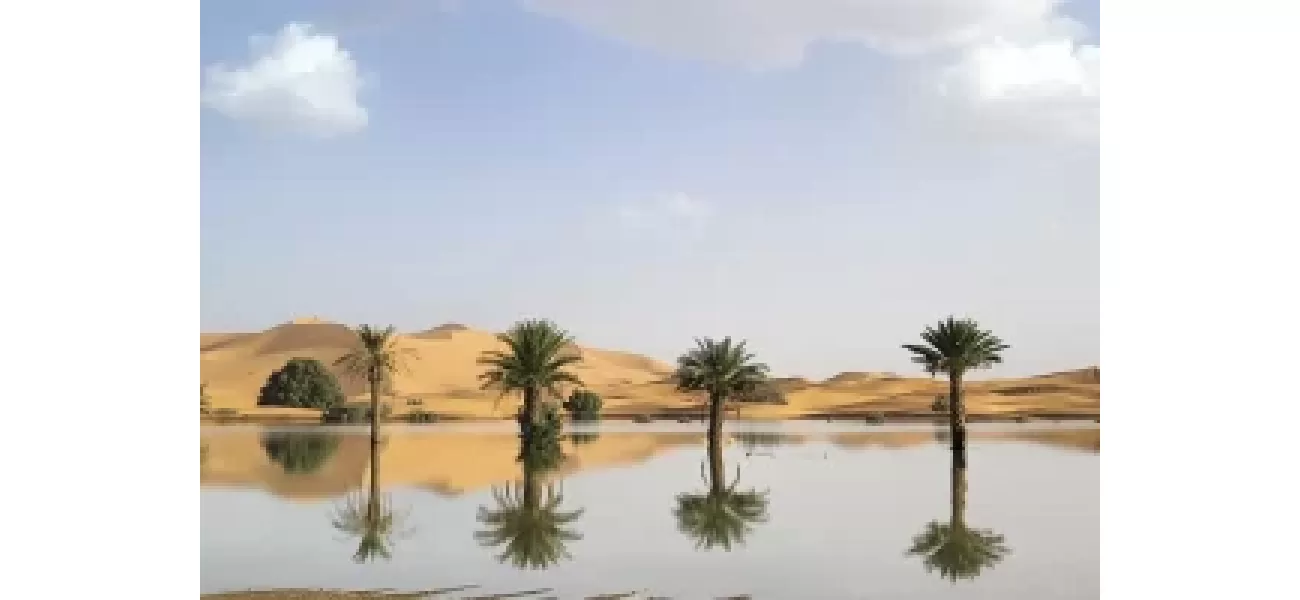Water pouring through sandy dunes in the Sahara desert after a rare rainstorm.
"Unusual rainfall in Rabat, Morocco brought water to dry Sahara desert, a rare occurrence for the arid region."
October 12th 2024.

In the usually parched desert of southeastern Morocco, a rare and unexpected downpour of rain transformed the landscape into a stunning oasis. The sandy dunes and palm trees were dotted with vibrant blue lagoons, nourishing the region with more water than it had seen in decades.
You see, this part of the Sahara desert is known as one of the most arid places on Earth, often experiencing little to no rain in the late summer months. So when the Moroccan government announced that two days of rainfall in September had exceeded yearly averages in certain areas, it was a momentous occasion. Even places like Tata, which typically sees less than 250 millimeters of rain annually, were hit hard by the deluge.
In Tagounite, a village located about 450 kilometers south of the capital city of Rabat, more than 100 millimeters of rain fell in just 24 hours. Can you imagine that? It's no wonder that residents were left in awe as they witnessed the usually dry and dusty desert being transformed into a sea of water.
The images of water rushing through the Saharan sands and filling Lake Iriqui, a famous lake bed that had been dry for 50 years, were truly striking. Even NASA satellites captured the dramatic change as the storm brought much-needed moisture to the region. Tourists in 4x4s drove through the puddles and locals marveled at the sight, something that hadn't been seen in decades.
According to meteorologists, this rare and powerful storm is being called an extratropical storm, and its effects may be felt for months and even years to come. As the air retains more moisture, it will likely bring more rain and storms to the area. This is a welcome change for a region that has been suffering from six consecutive years of drought.
The drought has had a significant impact on Morocco, with farmers leaving their fields fallow and cities and villages having to ration water. However, the recent rainfall will hopefully help refill the large groundwater aquifers beneath the desert, which are vital for supplying water to these communities. The region's dammed reservoirs have already reported record rates of refilling throughout September.
Unfortunately, the storm also brought some tragic consequences. More than 20 people lost their lives in Morocco and Algeria, and farmers' harvests were damaged. The government has allocated emergency relief funds to help those affected, including areas that are still recovering from last year's earthquake.
Overall, the rainfall in September was a blessing for this usually dry and harsh region. It's uncertain how much it will alleviate the effects of the drought, but it's a step in the right direction. And who knows, maybe this could be the start of a new trend for the Sahara desert, with more rain and water nourishing the land and communities for years to come. Only time will tell.
You see, this part of the Sahara desert is known as one of the most arid places on Earth, often experiencing little to no rain in the late summer months. So when the Moroccan government announced that two days of rainfall in September had exceeded yearly averages in certain areas, it was a momentous occasion. Even places like Tata, which typically sees less than 250 millimeters of rain annually, were hit hard by the deluge.
In Tagounite, a village located about 450 kilometers south of the capital city of Rabat, more than 100 millimeters of rain fell in just 24 hours. Can you imagine that? It's no wonder that residents were left in awe as they witnessed the usually dry and dusty desert being transformed into a sea of water.
The images of water rushing through the Saharan sands and filling Lake Iriqui, a famous lake bed that had been dry for 50 years, were truly striking. Even NASA satellites captured the dramatic change as the storm brought much-needed moisture to the region. Tourists in 4x4s drove through the puddles and locals marveled at the sight, something that hadn't been seen in decades.
According to meteorologists, this rare and powerful storm is being called an extratropical storm, and its effects may be felt for months and even years to come. As the air retains more moisture, it will likely bring more rain and storms to the area. This is a welcome change for a region that has been suffering from six consecutive years of drought.
The drought has had a significant impact on Morocco, with farmers leaving their fields fallow and cities and villages having to ration water. However, the recent rainfall will hopefully help refill the large groundwater aquifers beneath the desert, which are vital for supplying water to these communities. The region's dammed reservoirs have already reported record rates of refilling throughout September.
Unfortunately, the storm also brought some tragic consequences. More than 20 people lost their lives in Morocco and Algeria, and farmers' harvests were damaged. The government has allocated emergency relief funds to help those affected, including areas that are still recovering from last year's earthquake.
Overall, the rainfall in September was a blessing for this usually dry and harsh region. It's uncertain how much it will alleviate the effects of the drought, but it's a step in the right direction. And who knows, maybe this could be the start of a new trend for the Sahara desert, with more rain and water nourishing the land and communities for years to come. Only time will tell.
[This article has been trending online recently and has been generated with AI. Your feed is customized.]
[Generative AI is experimental.]
0
0
Submit Comment





